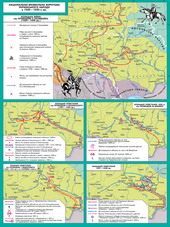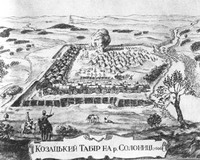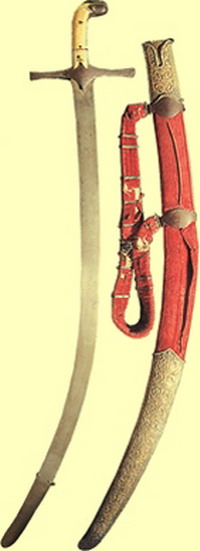CULTURE OF UKRAINE IN THE SECOND HALF OF XVI - first half of XVII century. DEVELOPMENT OF EDUCATION AND SCIENCE
Principal PROCEEDINGS
- Kyiv Mohyla Academy - the first and most famous university in the East Slavic lands.
CHRONOLOGY OF EVENTS
|
1491 |
publication in Cracow Shvaypoltom Fiolem first Ukrainian printed books. |
|
1556-1561 he |
Create Peresopnytsia Gospel. |
|
1574 |
Edition John F. Lviv Apostle and "primer". |
|
1576-1578 he |
Foundation Prince Konstantin Ostrog printing and schools of Ostrog literary science club. |
|
1581 |
in jail John F. Ostrog Bible published. |
|
1586 |
Foundation in Lviv Dormition Brotherhood and the Assumption School. |
|
1591 |
edition print shop Lviv Brotherhood Adelfotesa - textbook Church Slavonic and Greek languages. |
|
1596 |
Vilna printing house fraternity issued three educational books Zyzaniya Lawrence: "Primer", "Leksys", "grammar". |
|
1615 |
Shlyahtyanka Halshka Gulevychivna Kyiv Brotherhood gave his "yard of plyatsem" at the hem. Home of the Brotherhood school in Kiev. |
|
1616 |
purification of Kiev-Pechersk monastery publishes first book in the Prayer Book, designed for school use. |
|
1617 |
Foundation Chrestovozdvyzhenkyi Lutsk Brotherhood and Brotherhood school with him. |
|
1646 |
print shop Lavra published formulary Peter Graves. |
development of Ukrainian language
During
XVI - first half of XVII century. there were significant changes in the development of Ukrainian language. They related primarily literary language. from the Kievan Rus' long tradition of founding two literary languages: Old Ukrainian literary (in the second half of XVI century. Called her pr
Pr
Ruthenian language Slavic - Ukrainian version of Church Slavonic language. Religious books were written and continue Church Slavonic , which they called Slavonic-Ruthenian. And although it also exposed speaking Ukrainian, but the people remained unclear.
Peresopnitske GOSPEL
From the second half of XVI century. translations began to appear in the language of religious texts pr
- Peresopnitske Gospel (1556-1561);
- Krehivskyy Apostle (60's of the XVI century .);
- Volyn Gospel (1571) and others.
first known book of Scripture portrait of contemporary Ukrainian language is Peresopnitske Gospel.
- translation of Greek and Church Slavonic texts of the four Gospels made Peresopnytsia Monastery Archimandrite Gregory hieromonk. Translation copied son of Archpriest Michael Sanok.
- manuscript on parchment made from the use of black ink and cinnabar. 482 sheets of his framed in oak boards covered with green velvet.
Book - decorated with exquisite paintings, miniatures, and illuminations, arms, initials, ornaments, many who have felt the motives of the Renaissance period.
- In sight witnessed phonetic, grammatical, lexical and syntactic features live Ukrainian language of the XVI century.
Education. Status of School
- Traditionally schools operated by churches and monasteries. Specially trained clerics teach children writing Church Slavonic language, the basics of arithmetic, prayers and singing. First, such schools existed in major cities, then their number was increasing: in the second half of XVI century. they acted in Lviv Stryi, Rivne, Kremenets, gone astray, Vladimir-Volyn, in Zhitomir.
Deployment of the reform movement - resulted in the appearance Protestant schools . In particular, they were founded in Hoschi, Belz, Lviv, these days, Khmelnik.
- created their own schools and colleges and the Jesuits. The main goal of Jesuit educational institutions saw the conversion as much as possible to the Ukrainian Catholic faith.
Ostrog Academy
New features of the development of education is most embodied in Ostrih of cultural and educational center. It was created 1576 on the initiative of Prince Vasyl- Ostrozky.
- own goal for the activity he saw in the revival of Ukrainian culture on the basis of orthodoxy. To this end no later 1578 in jail was created school. The ancient Slavic traditions combined here with the heritage of contemporary European schools.
- in Ostrog school thoroughly studied languages - in Church Slavonic, Greek and Latin. Taught in it and "seven free sciences - grammar, rhetoric, dialectic, arithmetic, geometry, astronomy, music.
- School program, which was carried out studies in Ostrog schools included primary and secondary education to higher elements. Actually, as contemporaries called Ostrog school and school and colleges, and the Academy. It was the first in Ukraine, "Slavic-Greek-Latin" high school in Ukraine and East provinces.
- first rector of the Ostrog Academy was Gerasim Smotrytsky - a connoisseur of literature, poet, writer. At the invitation Ostrozky he came to gaff and headed circle of scientists who were preparing to print Ostrog Bible . Gerasim Smotrytsky was the chief translator and editor of this publication.
Brotherhood School
Enlightening and educational ideas were picked up Ostrog Academy of brotherhood. The need to counter offensive Catholic culture had led to communal schools.
- first such school appeared in Lviv in 1586 , and soon they began to form throughout Ukraine. At the beginning of the XVI century. Brotherhood schools were about 30. Enroll them in all children had the right conditions. Kept school at the expense of fraternities. Children of poor families and orphans were trained for free.
- main purpose of communal schools - to provide good education and nurturing a long tradition and commitment to their ancestral faith. That is why much attention is paid to such schools in the study of Church-portrait and Ukrainian languages. Traditionally studied and Greek. In those times it was difficult to do without Latin - the language of science and Western diplomacy.
- brotherhood schools, as well as Ostrog school were Slavic-Greek-Latin. In these languages, students acquire them is referred to "seven free sciences".
In - 1615 appeared Brotherhood School in Kiev . Its foundation have committed themselves scientists, writers and poets, leaders of the Orthodox church, gathering around the Archimandrite of Kiev-Pechersk Lavra Elisha Pletenetsky.
- first rector of the Kyiv Brotherhood school was Job Boretsky.
- spring 1631 in Kiev there was another school - Lavra. Founded by Archimandrite of Kiev-Pechersk Lavrov Peter May. Soon Lavra school was merged with the Kyiv Brotherhood. Joint School began operations in September 1632 it was called college.
Kyiv Mohyla Academy
- Kiev board (soon to Kyiv Mohyla Academy) had a higher educational institution.
- full course lasted 12 years. A total of eight Academy classes and the number of subjects exceeded 30. The basis of the subjects they were still "seven free sciences".
- In the first four grades Academy studied languages: literary Ukrainian, Church Slavonic, Greek, Latin and Polish.
All - higher science at the Kyiv Mohyla Academy taught, as elsewhere in Western Europe, Latin.
However - care at the academy and the proper knowledge of the Ukrainian language: it is scientific activity teaching staff and students contributed to the development of Ukrainian language.
- Kyiv Mohyla Academy for a long time was the only institution of higher education for all states of Ukraine, Eastern Europe and the Orthodox world.
DEVELOPMENT BOOK
establishment of a permanent book publishing in Ukraine connected with the name of the Moscow Printing pioneer John F. (Fedorov).
- suffered persecution in Muscovy, it is in the early 70's of the XVI century. arrived in the city.
- In 1574, in Lviv, Ivan F. gave apostle and the first Ukrainian printed textbook for teaching reading - "Primer".
- in 1581 in jail F. gave real masterpiece among old - Ostrog Bible.
- the middle of XVII century. Ukraine had 25 printing companies in 17 different towns and villages.
- First there were many small private printing presses, publishing books but gradually concentrated in the largest printing houses - Kiev-Pechersk Lavra L'viv Brotherhood, Michael Slozky, Lviv Jesuit College.
- the center of publishing in Ukraine in the first half XVII. was printing Lavra.
She founded - 1615 Archimandrite Monastery he Pletenetsky.
- Lavra printing first book published in 1616, during the second half XVII. there were 120 articles published books - especially worship books and primers, dictionaries, calendars, work history, etc..
- Nayuslavlenishe publication of the time - formulary Peter Graves.
In - 1638 in printing came Teraturhima Caves Monastery monk Athanasius Kalnofoyskoho - invaluable source on the history of the famous monastery.
- Printing Lavra survived for over 300 years. Issued in it worship the book had its own characteristics. They mainly contain preface, epilogue, dedication, poetical insertions, which was a distinct feature of the Ukrainian character that influenced the language publications and their design.
 English
English









